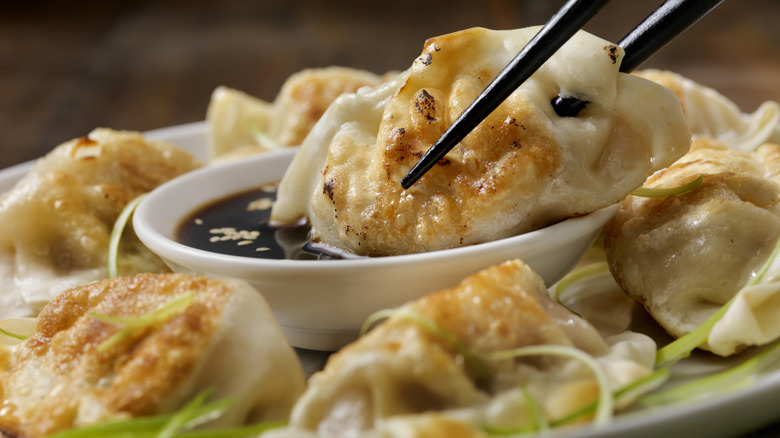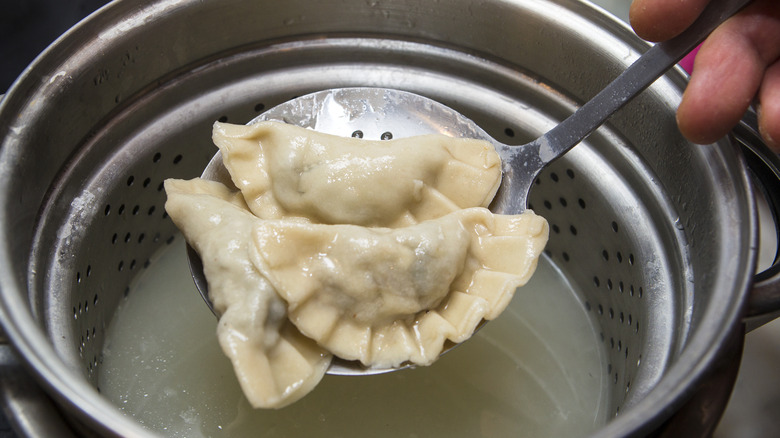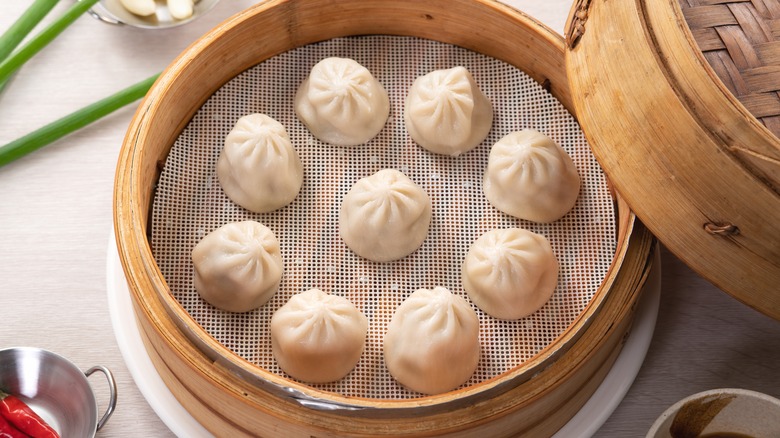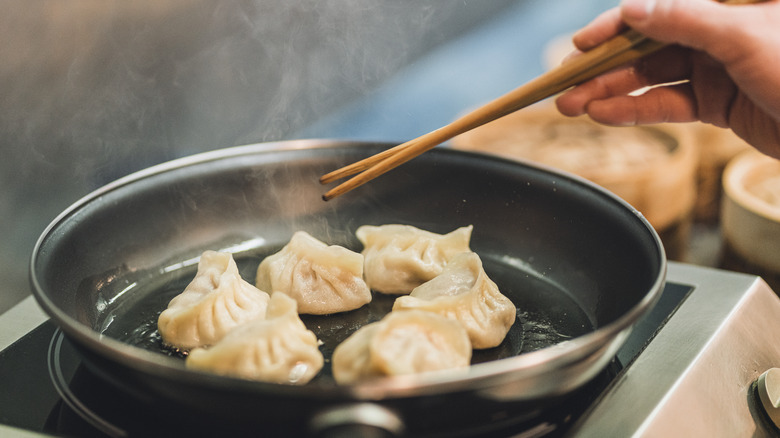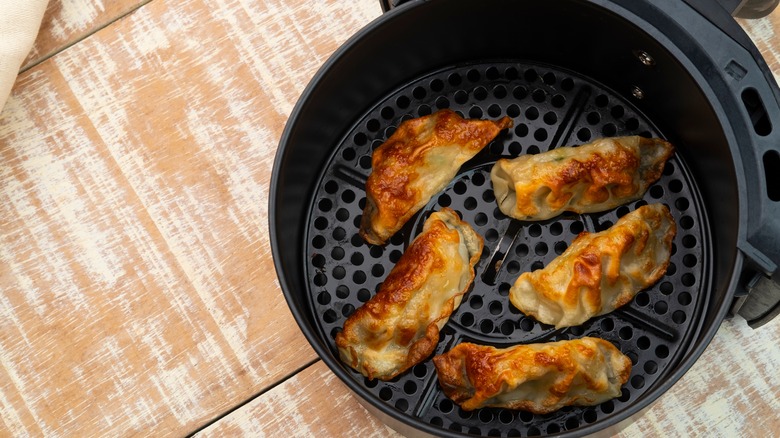The Absolute Best Way To Cook Dumplings From Frozen
Convenient, easy to store, and delicious, frozen dumplings are quickly becoming a must-have freezer staple in the modern-day struggle of time and budget management. It's no wonder frozen dumplings enjoyed a renaissance during the pandemic: With a long shelf life in the freezer and an easy cooking process, frozen dumplings are versatile pockets of deliciousness that are perfect as low-effort snacks or last-minute appetizers that don't need a grocery trip or tons of prep beforehand. Not to mention instant, pre-cooked frozen dumplings are a quick way to elevate your instant ramen into something much more filling.
So, what's the best way to cook dumplings from frozen? It depends entirely on your preference — you'll want to boil them for that melt-in-your-mouth softness, steam them for a satisfying chewiness, or pan-fry them for a crisp bite. However, not all dumplings are made the same. Depending on the shape, size, and whether they're raw or pre-cooked, some dumplings lend themselves better to some cooking methods than others. Unfortunately, you can't always trust the instructions given on store-bought packs to give you the best results. So if you want to get the most out of your frozen dumplings, there are a few tips and best practices to know for each cooking method.
The absolute best way to boil frozen dumplings
For the most part, frozen dumpling packets will instruct you to add the dumplings to water and boil for a certain number of minutes before draining and serving. While this method works fine for pre-cooked instant dumplings, you might find that raw dumplings end up with unpleasantly mushy skins. This is because dumpling skins cook faster than the insides, and tend to get overcooked while boiling in the water long enough to cook the filling to a safe temperature.
Fortunately, there's a more optimal way of boiling frozen dumplings. The key is to moderate the amount of heat the dumpling skins are exposed to. The first step is to make sure you don't pre-thaw your dumplings before cooking and throw them in straight from frozen. You'll want to add them after the water comes to a full boil to minimize the time the skins are thawing and soaking in the water before the insides start to cook. After that, you'll need to boil the dumplings until they rise to the top, then add a cup of cold water to douse the skins. Wait until the water boils again, then add another cup of cold water when the dumplings rise a second time. The dumplings should theoretically be done by the second time they rise, but you can repeat the process a third time if they're still a little cold in the center.
Steaming dumplings for quality or for speed
Another classic way of cooking frozen dumplings is to steam them. It's a relatively easy and foolproof method that'll yield chewy and tender dumplings, with the only minor downside being that you'll need some sort of steaming setup. A traditional bamboo steamer is best because of its ability to minimize moisture build-up on the inside, subsequently reducing the risk of soggy spots or undersides to the dumplings. But whether you're using a bamboo steamer or a metal or ceramic one, it's important to check the dumplings for doneness at around six minutes — unlike pasta boiling times, the best steam times for dumplings can vary based on the type of dumpling as well as the quirks of your stove or steaming appliance.
If you're more worried about convenience than optimal quality, the good news is that you don't need a proper steamer to steam dumplings. A heatproof colander placed on top of boiling water will work just as well as a metal steaming basket in a pinch. If you're really strapped for time and just need to cook a batch of instant dumplings, the microwave is the easiest and speediest alternative: Place the dumplings in a bowl with a shallow layer of water and cover it before microwaving it for one to three minutes, depending on the size and number of dumplings. Covering the bowl with a damp paper towel can also help things along in this improvised steaming process.
Understanding how to perfectly pan-fry frozen dumplings
It's important to note that you shouldn't fast-steam raw frozen dumplings in the microwave. The USDA advises against microwaving raw food unless you're able to thoroughly check the heat distribution throughout the process, which more or less defeats the purpose of using the microwave as a convenient alternative. However, microwaving can still be used as a shortcut for tasty and well-cooked raw dumplings — the key is that you're using the microwave to soften them up before putting them in a hot pan for a crispy, pan-fried batch. You'll want to wait until the dewy moisture on the dumplings has evaporated a little before throwing them in to minimize oil splattering.
The proper, non-shortcut way of pan-frying frozen dumplings also involves some improvised steaming, with water added directly to the pan while the dumplings are cooking. Heat a non-stick pan with some neutral oil with a high smoke point, then add the frozen dumplings while being mindful of any splatters from the melting frost coming into contact with the hot oil. Once the bottoms are crispy and golden-brown, add water until the dumplings are half-submerged and cover to trap the steam in. Depending on their size and shape, the dumplings should only take between five to 10 minutes to cook fully. Ideally, you shouldn't check on them and let the steam escape, but put cooking safety first, and don't be afraid to poke around until you get the timing right.
Thinking outside the wok
The versatility of dumplings means that you don't have to cook them in conventional ways to get great results. If you prefer the crispiness of pan-fried dumplings above all else, why not try cooking them in an air fryer?
In fact, air frying might be the method that has the best balance of convenience to quality, giving you crisped dumplings with only a little prep and button-pushing. All you have to do is cook the dumplings like you'd cook any other air fryer-ready frozen product. Line the basket, place the dumplings in a neat single layer, coat the dumplings in a neutral oil with a high smoke point for a crispy finish, then fry them at around 350 degrees Fahrenheit for five to seven minutes.
An important thing to note is that for most intents and purposes, an air fryer is just a compact and specialized convection oven: If you don't have an air fryer, you can still get similar results by using a conventional oven. Just preheat the oven to 380 degrees Fahrenheit, line a tray with a baking sheet or parchment paper, then layer the dumplings and coat them with oil before popping them in. They should be done in about 15 to 20 minutes — give or take depending on the size of the dumplings — leaving you with perfectly crispy, golden brown dumplings to enjoy.
